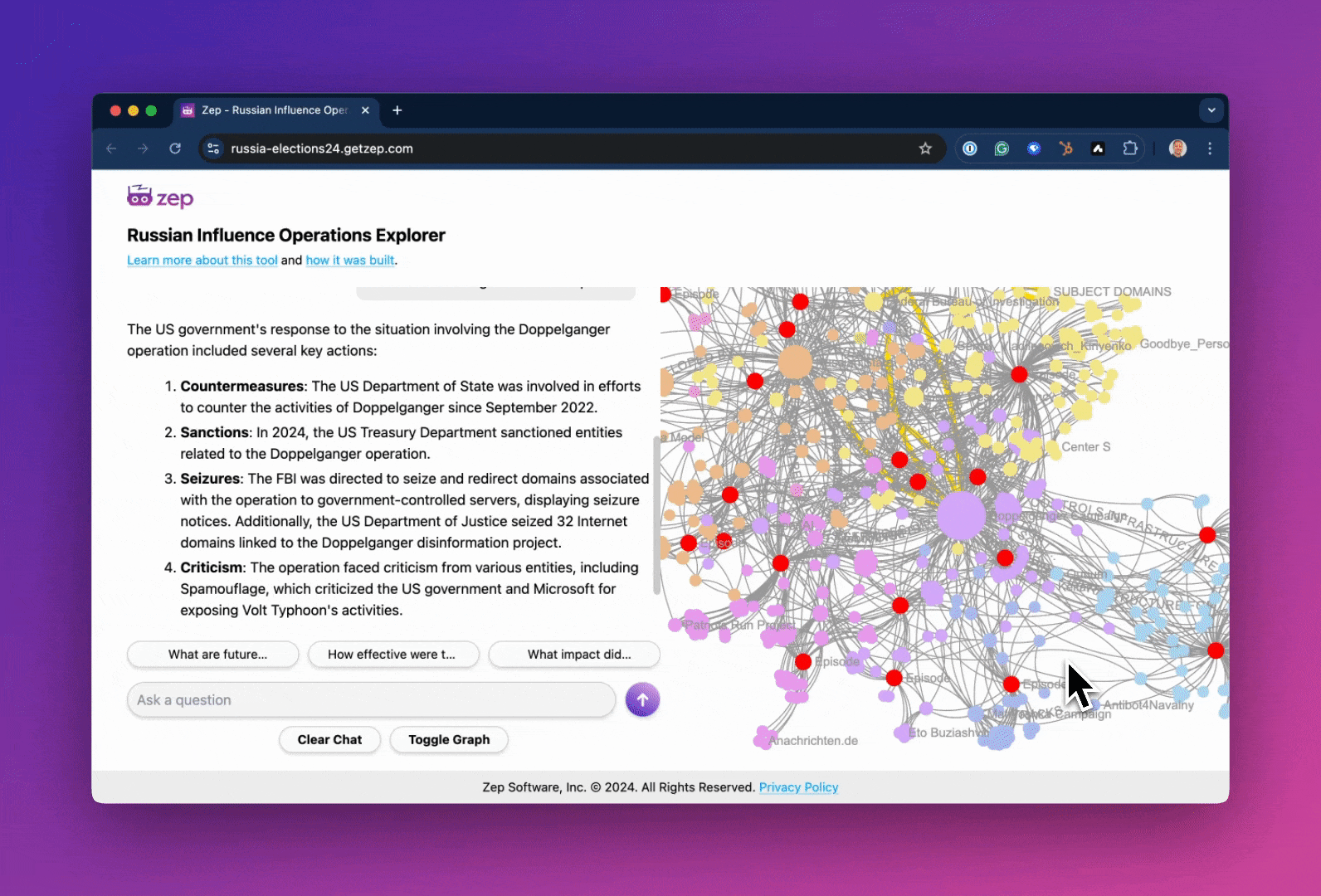Exploring Russian Election Interference with a Knowledge Graph
We built a visual exploration tool and AI assistant for analyzing Russian interference in the run-up to the 2024 US elections.

1. Zoom into the graph using your mouse scroll wheel.
2. Hover over a node and read its summary.
3. Hover over an edge to read the fact derived from the relationship between adjacent nodes.
4. Click on a red Episodic node to read the article from which the related nodes and edges were extracted.
Graphiti is an open-source Knowledge Graph library at the core of Zep's memory layer for AI agents. Graphiti autonomously builds dynamic, temporally-aware knowledge graphs representing complex, evolving relationships between entities. In the run-up to next week's US election, we've used Graphiti to power our Russian Influence Operations Explorer: a knowledge graph visualization and related Q&A bot for exploring Russian state operations to influence US election outcomes.
We built the graph using a range of sources, including US DOJ indictments, US and foreign government research, non-governmental organization research, and media articles, to offer users a detailed view of these operations. Using our graph, you can explore which US organizations and individuals are implicated in these efforts and learn how private entities (such as OpenAI, Meta, and others) have responded to these challenges.
Two operations stand out in this dataset: Doppelganger and Tenet Media. The Doppelganger operation's multinational scope required us to draw from both US and European sources to capture its full impact. For Tenet Media, we used diverse sources, ranging from federal government reports to Variety magazine's industry coverage, to illuminate the company's collapse and its broader implications for the media landscape.
How the Explorer works
Graphiti ingests data as a series of episodes, with a single data artifact constituting an episode. Nodes extracted from an episode's data will have an edge relationship with the Episodic node (marked in the graph in red). In our implementation of Graphiti, the red nodes include a reference to the source article or paper. Click on one to see where the graph entities came from!
Let's walk through an example research task. We want to explore the Russian state's use of sock puppet media and non-profit groups and ask the assistant how Russia uses these. Following a second or two of research, the assistant focuses the graph on relevant nodes and edges, and responds with a summary.

We notice an interesting organization, the Patriots Run Project, and zoom in.
Exploring the graph, we see that the fake social media accounts used in Patriots Run Project operation were acquired from entities or individuals in Bangladesh.

We asked the assistant for more information and learned that Russia was using the project to influence US conservatives.

Sources are important. The assistant will provide a list of sources used to answer your question. We currently provide the top 5 sources, but all sources for nodes or edges in the graph are available by clicking on a related red episodic node.
Next Steps
- Visit the Explorer Application.
- Read more about Graphiti.
Bibliography
This project uses the sources listed below. They were selected based on their authority and diversity, and were available online as of Monday, October 28, 2024. (UPDATED 11/04/2024).
Government Agencies
-
Joint ODNI, FBI, and CISA Statement on Russian Election Influence Efforts (November 1, 2024)
-
Department of Justice - U.S. v. Kalashnikov and Afanasyeva Indictment
-
National Intelligence Council - Foreign Threats To US Elections After the Voting Ends in 2024
-
USMC - The Matryoshka Doll: A Model for Russian Deception, Disinformation, and Chaos
-
German Federal Office for the Protection of the Constitution - Doppelgänger Analysis
Non-Governmental Entities
-
Correctiv - Inside Doppelganger – How Russia uses EU companies for its propaganda
-
DFRLab - Russia-based Facebook operation targeted Europe with anti-Ukraine messaging
-
DFRLab - Russia-linked operations target Paris 2024 Olympics
-
DisinfoLab - Doppelganger: Media clones serving Russian propaganda
-
Logically Facts - Inside the indictment alleging secret Russian funding of U.S. content company
-
Microsoft - How Russia is Trying to Disrupt the 2024 Paris Olympic Games
-
OpenAI - Disrupting deceptive uses of AI by covert influence operations
Media Organizations
-
BBC News - Right-wing US influencers say they were victims of alleged Russian plot
-
CNN - DOJ alleges Russia funded US media company linked to right-wing social media stars
-
Forbes - YouTube Takes Down Alleged Russia-Funded Outlet Which Hosted Videos From Right-Wing Pundits
-
Foreign Policy - Russia's Global Information Operations Have Grown Up
-
Guardian - US conservative influencers say they are 'victims' of Russian disinformation campaign
-
NPR - How Russian operatives covertly hired U.S. influencers to create viral videos
-
Semafor - Blaze fires contributor linked to alleged Russian operation
-
Social Media Today - Meta Bans Russian State Media in the Wake of Covert Influence Program
-
Tech Policy Press - Russian Indictments Highlight US Limitations in Fighting Disinformation
-
Tennessean - What to know about Tenet Media, Tennessee company linked to Russian propagandists
-
Washington Post - Justice Dept. charges two Russian media operatives in alleged scheme
-
Washington Post - How I became a propagandist for Russian media
-
Washington Post - Inside Tenet Media, the pro-Trump ‘supergroup’ allegedly funded by Russia
-
Wired - Right-Wing Influencer Network Tenet Media Allegedly Spread Russian Disinformation
-
Wired - What Right-Wing Influencers Actually Said in Those Tenet Media Videos
-
Yahoo News - What to know about Tenet Media, Tennessee company linked to Russian propagandists
-
The Hill - DOJ Shines a Light on Russian Use of Conservative Influencers
-
New York Times - OpenAI Says Russia and China Used Its AI in Covert Campaigns
-
New York Times - U.S. Accuses Russian TV Network of Conducting Covert Intelligence Acts
-
New York Times - Meta and YouTube Crack Down on Russian Media Outlets
-
New York Times - How the Kremlin Finds Ways to Spread Its Messages
-
NBC News - How Elon Musk amplified content from a suspected Russian election interference plot

